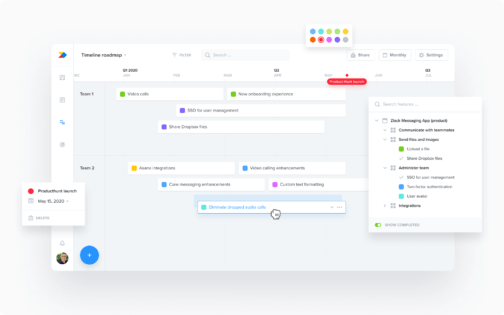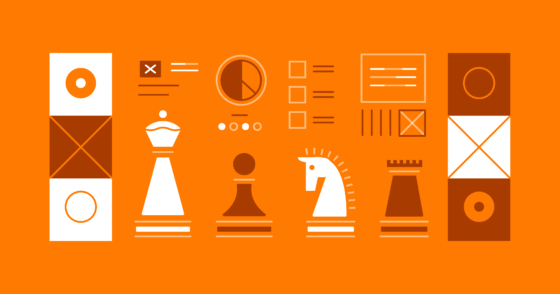Roadmap vs. release plan: What’s the difference?

As a product manager, you rely on several tools and artifacts to help you document and communicate your work. Two popular examples are roadmaps and release plans. These are similar tools that are often conflated. But there are some important distinctions between them that are worth investigating.
What is a roadmap?
A product roadmap is a visual representation of how products and features are being created within a company. Done correctly, the most important thing a product roadmap does is unite all company teams behind a common goal. They also:
- Explain the “why” behind the product or features being developed (aka the vision)
- Communicate prioritized plans to internal and external stakeholders
- Provide overall direction for the product development process and show how desired results will be achieved
Roadmaps tend to be more conceptual documents that illustrate the steps toward your product vision. They are often grounded with objectives—clear, measurable, inspiring goals aligned with specific outcomes you’re striving to achieve for your customers, product, or business.
It’s hard to overstate the importance of a good roadmap. At Productboard, an inspiring roadmap is one of the pillars of Product Excellence, along with deep user insights and a clear product strategy.
What is a release plan?
Release plans, on the other hand, are the execution-level plan of how you’ll deliver the work that you’ve decided to do and the timeframe when that work will be completed.
Making the distinction is important because you use both documents to communicate with stakeholders. As product consultant and thought leader Rich Mironov writes, “I think of roadmaps as communication vehicles rather than decision vehicles. A lot of folks say their goal is to have a roadmap. And I say no, our goal is to have a good product strategy where we make hard choices and prioritize the right things. The roadmap is simply a reflection of this.”
You don’t want to set unrealistic expectations for stakeholders at a time when you know the least (the outset of a project). Instead, you can use your roadmap to communicate the big picture of how the product impacts business objectives. Then drill down with a release plan to communicate the milestones and dates that will help you get there.
The key components of roadmaps and release plans
Roadmaps aren’t stand-alone documents—they’re the culmination of several Product Excellence best practices, like:
- An organized system for collecting and organizing feedback from customer-facing colleagues and removing bottlenecks around customer feedback.
- A transparent process for surfacing valuable insights hidden within that feedback.
- An objective method for using those insights to prioritize tasks on the product roadmap.
- A closed-loop system for sharing the roadmap with stakeholders and customers and for obtaining further feedback
This means that good roadmaps will help you understand what’s happening, when (in a general sense over the next 12 months or so), and why. Here are a few of the key components roadmaps can include:
- Timeline: Even in the agile world, it is important to set expectations around when short-term, medium-term, and long-term features will roll out so other teams can plan around them. Again, we’re sticking with broad time frames and not talking about specific dates or deadlines here.
- Solutions: Communicate what features you want to roll out in the above timeline. You can be as high-level or as detailed as you want, just explain why you are including each feature to give context.
- Strategic context: Let all teams know where the product is headed and why you’re building these features next. Currently, only 44% of product teams are confident that their roadmaps reflect the strategic context behind what they’re building. If some roadmap decisions are hard for certain stakeholders to swallow, strategic context helps them to understand the rationale behind tough trade-offs, even if they don’t personally agree with it.
Your release plan will be a more tactical document that includes your product backlog items and the timeframe for addressing them. Keep in mind that your release plan will cover a much shorter timeframe than your roadmap—think three to six months rather than an entire year.
What are the key differences between roadmaps and release plans?
Roman Pilcher offers a great explanation of the key differences between roadmaps and release plans. He writes:
“A product roadmap communicates how a product is likely to evolve across several major releases. Unlike the release plan, it is a product plan that looks beyond an individual project or release: It describes the journey you want to take your product on over the next 12 months or so—much like a roadmap helps you plan a road trip.”
Here is a quick guide to some of the biggest differences between the two.
| Roadmap | Release plan |
| High-level overview, describes the journey | Zoomed in, detailed view of the specific steps |
| Covers a longer time frame—usually about 12 months | Covers a shorter time frame—usually 3–6 months |
| Often used to communicate with stakeholders like executives and customer-facing teams | Often used to create alignment between product and engineering teams |
| Focuses on why you’re doing something based on user insights and strategy | Focuses on what you’re doing and when you’re committing to having it completed |
Why you need both a roadmap and a release plan
As we’ve discussed, roadmaps and release plans are related but distinct tools. If you’re looking to document and communicate your high-level vision and some of the milestones you’ll hit along the way, that’s where your roadmap will come in handy. And if you’d like to get a little more granular about what’s coming up in the near-term and when these steps will be complete, you’ll want to use your release plan for that.
Product managers are always tightrope walking the line between being strategic and tactical—between defining where your product is going and how you’ll get there. And you rarely work alone. There’s a rotating cast of stakeholders including your executives, customer-facing teams, and engineers, who all have different priorities and areas of interest. Creating both a roadmap and a release plan—and having a clear distinction between the two—helps ensure that everyone has access to the information that’s most meaningful to them.







